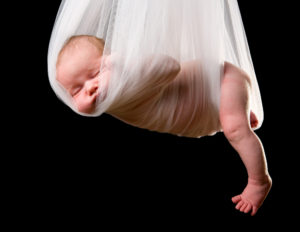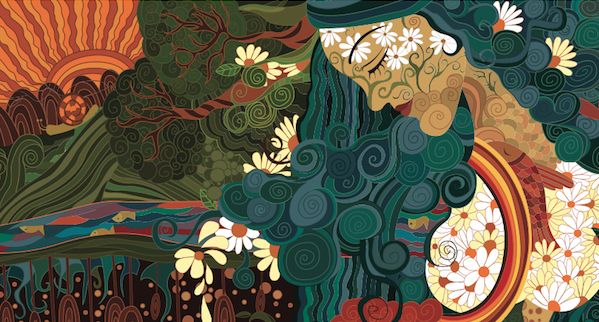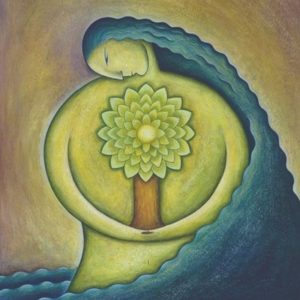
Hannah, Delivered is a lyric exploration of the challenges of birthing: the birth of a child that makes a woman a mother, and the birth of the self that makes a woman an integrated, fully-realized adult. Hannah finds the second through her experience of becoming midwife to the first, and her journey is filled with challenge, splendor, tough love, raw honesty, and a gentle-voiced, rousing crusade in favor of natural childbirth.
Elizabeth Jarrett Andrew is, in practice, a midwife of another sense: she is a teacher and practitioner of the art of spiritual memoir, a discipline that intertwines the close, fine attention of the contemplative life with the close, fine attention demanded by clear, accurate writing that tells a genuine story free of stereotype, formula, and cliché. I had her book Writing the Sacred Journey on my bookshelf before I reviewed Oh, Baby! for these very pages, and when she sent me her novel to read, I was impressed at how beautifully she threads together these three very similar pursuits: the spiritual path, the mothering path, and the writing path. She finds the spiritual aspect of mothering and writing, the way the challenges of both endeavors plumb and painfully expose all the broken, fractured, contaminated, or otherwise putrefying parts of us (or is it just me?). She is wise to the ways that writing is like mothering (exhausting, repetitive, full of constant revision, never complete) and how attempting to do either of these activities attentively and well necessitates a profound mind-body transformation (or transfiguration?) of the truly spiritual sort.

It is perhaps this spiritual work that makes Jarrett Andrew’s sentences so translucent, each a polished pearl; each one seems to have arisen from focused, clear, meditative thought. Some passages, especially short paragraphs that precede several of the chapters, break into real poetry. The opening pages include an image of the embryonic narrator seeking water to soothe her and connect her to her mother after her mother’s death:
Where is Mom now? Released back into creation, surely, part of the water’s chill, the comforting sun, the enormous darkness holding me. I hadn’t connected with her dead body but now I imagined a cord spiraling like pondweed from my center downward through tannin-stained sunlight into muck, into her. The cord swayed in the lake’s currents. Quiet pressed my eardrums. Here, finally, I knew her. I accepted the silence, the water’s embrace, and the sustenance seeping up, up.
Hannah narrates in first-person the story of her emergence from her humdrum life as a hospital worker in metropolitan Minnesota, about to be married to the sweet but humdrum Leif, when she unexpectedly helps the hospital midwife develop a baby. The event shocks her into the raw awareness that if she is looking for something real in her life, some experience that is essential and fundamental and transformative in every way, birth has to be it.
The baby, that stunningly aware, miniscule body, had erased everything . . . Suddenly, I knew that baby had emerged from the same place my mother had gone. I didn’t belief in heaven but what else could explain that profound sense of continuity? He filled a hollow place in me, forcefully, irrevocably.

With mentoring from the midwife, Maryann, Hannah enters an apprenticeship at The Birth House, a midwife training center in New Mexico, and gains the skills she will need to come back to establish her own practice in Minnesota, in the rural town where she grew up. It’s the mid-90s, and midwifery—not to mention natural birth—is still a woo-woo, New Age thing; it’s barely legal in New Mexico, and not legal at all in Minnesota. Hannah’s clients are from-the-earth hippies, religious fundamentalists, European expats who think American birth practices are weird, and immigrants who can’t afford insurance.
 The illegality of what she’s doing looms over the entire novel; it begins with a hint that Hannah spent some time in jail, and ends with describing the birth scenario that landed her there (it’s not exactly a spoiler if page one tells you it’s coming). The continued references to Hannah’s law-breaking defiance never really pay off with all the danger and suspense they hint at, since the reader never sees the jail time, the brief publicity, the public accusations, the repair of her career. Instead, the recollection of Hannah’s journey to fully embrace her calling as a midwife is delivered to her apprentice, an unnamed character whom she educates in the profession.
The illegality of what she’s doing looms over the entire novel; it begins with a hint that Hannah spent some time in jail, and ends with describing the birth scenario that landed her there (it’s not exactly a spoiler if page one tells you it’s coming). The continued references to Hannah’s law-breaking defiance never really pay off with all the danger and suspense they hint at, since the reader never sees the jail time, the brief publicity, the public accusations, the repair of her career. Instead, the recollection of Hannah’s journey to fully embrace her calling as a midwife is delivered to her apprentice, an unnamed character whom she educates in the profession.

Narratively, the book is stitched together like a finely patterned quilt. The paragraphs are soft, perfect squares, each contributing some feeling or understanding or concern that moves the story forward. Characters develop slowly but in interesting ways. It took me a while to get a grasp on Stuart, Hannah’s flaming, highly woo-woo, wonderfully amusing co-apprentice at The Birth House; it took me longer to understand Loren, her hemmed-in Lutheran preacher father, and Chuck, his earring-sporting assistant. The moments of poetry surface throughout, providing a savory counterpoint to the main action, a quiet moment of reflection, often of discovery. Hannah’s evolution is believable, her grief heartfelt, and when a shocking realization about her own birth comes along to validate everything the reader-apprentice has been receiving patient, steady instruction in (which is the beauty of natural childbirth and the tragedy that medicalized birth makes of a beautiful primitive act), the message of the book is underscored in deeply resonant ways.
 I rooted for Hannah. I wanted her to reach out and grab for what she wanted with both hands. I was glad when she did. In the final scene, I found myself tearing up, testament to the moving nature of Hannah’s final triumphant emergence. It’s a long-held tradition of mine to cry when I witness a birth, babies of all sorts; it’s good to know the tradition holds when I read about fictional births. Ask me if I’m persuaded if natural childbirth is the way to go and I, gently coached by this book, will say, amen, sister, you bet! All of the information woven into the narrative—it’s a birth class of its own, in a way—celebrates these ageless rituals of human civilization: gestation, laboring, delivery.
I rooted for Hannah. I wanted her to reach out and grab for what she wanted with both hands. I was glad when she did. In the final scene, I found myself tearing up, testament to the moving nature of Hannah’s final triumphant emergence. It’s a long-held tradition of mine to cry when I witness a birth, babies of all sorts; it’s good to know the tradition holds when I read about fictional births. Ask me if I’m persuaded if natural childbirth is the way to go and I, gently coached by this book, will say, amen, sister, you bet! All of the information woven into the narrative—it’s a birth class of its own, in a way—celebrates these ageless rituals of human civilization: gestation, laboring, delivery.
But I could not help—I will admit it—feeling a little accused. I gathered the sense (and I simply could be too sensitive here; we’ll talk about my own birth stories in a moment) that to be a champion of natural childbirth is to be deeply and passionately opposed to the rituals of hospital birth in the U.S.: time schedules for labor, drugs for pain, drugs for inducing, drugs to stop labor, utensils to make the baby come out, stitches to fix everything after. Hannah only made a few sniping comments toward Bill, the intervention-happy town OB, but each time they made me flinch. Maybe it’s wrong to feel as I do , to be able to hold two conflicting ideas at the same time: that natural childbirth is the ideal, a narrative for how the biological female body is supposed to engage with the process of emitting a child, and that hospital intervention can be very, very good if your body doesn’t fit the narrative.
I’m not promoting one over the other (though I daresay the book may be , at least implicitly, and I daresay lots of women do, mothers or not). As with most things affecting the female body, I say the woman inhabiting the body gets to decide. But the thing that kept me from fully embracing Hannah’s experience was the knowledge that she would secretly disapprove of me. And here’s where we get to my birth stories. I had planned, both times, to have a natural childbirth—I bought the yoga of labor books, declined the epidural, did the breathing exercises and packed essential oils in the birth bag—both times, in the actual moment of crisis, neither baby nor I cooperated with the script, and a medical intervention probably saved all three of us from larger problems down the road.
, at least implicitly, and I daresay lots of women do, mothers or not). As with most things affecting the female body, I say the woman inhabiting the body gets to decide. But the thing that kept me from fully embracing Hannah’s experience was the knowledge that she would secretly disapprove of me. And here’s where we get to my birth stories. I had planned, both times, to have a natural childbirth—I bought the yoga of labor books, declined the epidural, did the breathing exercises and packed essential oils in the birth bag—both times, in the actual moment of crisis, neither baby nor I cooperated with the script, and a medical intervention probably saved all three of us from larger problems down the road.
I’ll be brief. You know how baby skulls are supposed to shift so they can progress down the birth canal? Baby one’s didn’t. Add to that her head being a full inch and a half larger in diameter than the top of the normal scale, and you see the complications. When I’d already been pushing two hours and she hadn’t budged, when her heart rate started dropping and the magical hidden cabinet in the birthing room opened, I didn’t make any complaints about medical interventions. My OB asked if I wanted to cut or tear; I chose tear, because all the natural childbirth books said you heal better after a tear, and that was probably really stupid. It took a vacuum to get her out, and even then her head was as round as a basketball and almost as large. She was perfect, mind you, but I can still see the faint birthmark on her forehead from being squeezed so long in the canal. Trained midwives probably have ways of dealing with this, and would probably be happy to tell me how they could have helped. From my POV, with my unbudging baby’s basketball head, we needed that vacuum extractor to get her out, and I needed those stitches after.
 Which brings us to baby two, the macrosomia case, the watermelon baby, fed with too many chocolate shakes. Here again a skilled midwife would have let me labor; I know the nurse who gave me a tour of the birth facility assumed as much. But my team of OBs looked at the last ultrasound and asked me to schedule a C-section. When I went into labor a week later, it turned into a emergen-C, and I understand the argument again—complications with a C, riskier outcomes for mother and baby, more than can go wrong when a natural biological function turns into a surgery. He wasn’t quite as big a watermelon as we’d supposed, but what my doctors hadn’t observed—in fact, what only I and my husband knew—was that my perineum remained mostly scar-tissue from that earlier, magnificent tear. I still believe that baby would have been strangled coming through the ring of fire and some sort of intervention would have been necessary anyway, and more dangerous in those moments when oxygen stands to be cut off.
Which brings us to baby two, the macrosomia case, the watermelon baby, fed with too many chocolate shakes. Here again a skilled midwife would have let me labor; I know the nurse who gave me a tour of the birth facility assumed as much. But my team of OBs looked at the last ultrasound and asked me to schedule a C-section. When I went into labor a week later, it turned into a emergen-C, and I understand the argument again—complications with a C, riskier outcomes for mother and baby, more than can go wrong when a natural biological function turns into a surgery. He wasn’t quite as big a watermelon as we’d supposed, but what my doctors hadn’t observed—in fact, what only I and my husband knew—was that my perineum remained mostly scar-tissue from that earlier, magnificent tear. I still believe that baby would have been strangled coming through the ring of fire and some sort of intervention would have been necessary anyway, and more dangerous in those moments when oxygen stands to be cut off.
So, that’s my full disclosure. I couldn’t fully participate in Hannah’s passionate convictions because both of my children were delivered safe, whole, and intact because of an incision. My body didn’t turn out to be as wise as I’d hoped or wanted it to be. Therefore, when Hannah had her moments of trust-the-woman’s-body and scorn-the-medical-establishment, I guiltily hung my head; when her female characters insisted they would make grand organic gestures like give birth on the open ground, in the open air, I deeply resented that their bodies did the right thing, that their babies cooperated. More than that, because of Maryann’s insistence that we are marked by our births, I am now worried that both my children bear some sort of psychic scar from their medicalized births, because I couldn’t be she-woman/primitive animal enough to squeeze them out on my own. I don’t need that burden, on top of everything else.
But none of this takes away from the sheer, lovely, unalterable fact that this is a beautifully-written, beautifully-thought out, deeply and beautifully human book. It takes an honest look at the most fundamental things about our lives—pregnancy and birth, death and loss, relationships, family, faith, vocations; our relationships with the natural world, our relationship with ourselves—and remains touchingly convinced that truth and beauty will win. It’s a book well-deserving of the awards and praise heaped upon it, and it will inspire the reader to reflect on her own life-path, to be sure she is listening to the call of her deepest heart.


